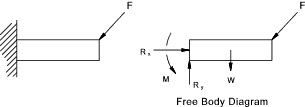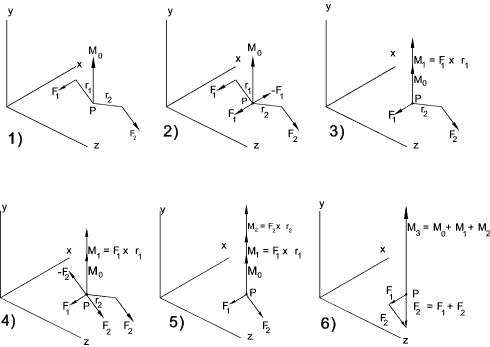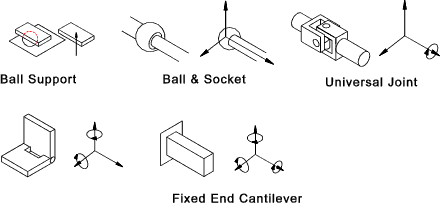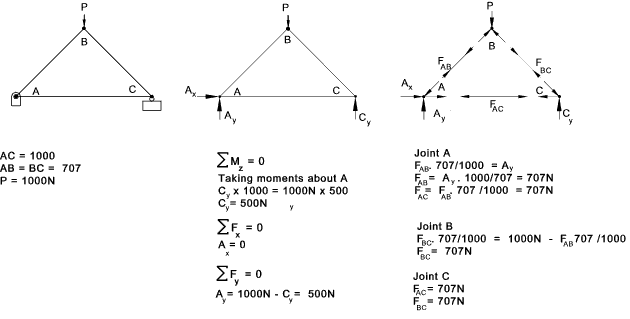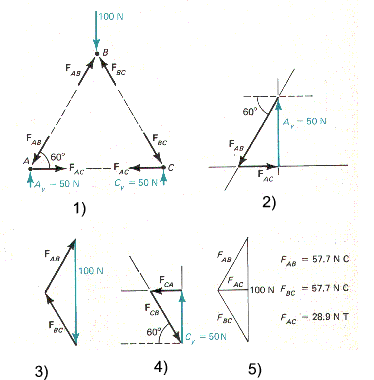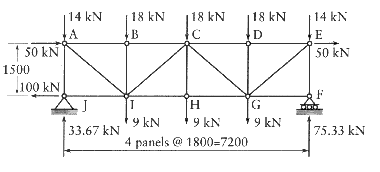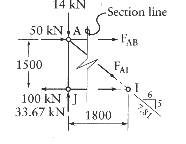| |
Mechanics Index
Introduction to Statics
|
Introduction Statics deals equilibrium of stationary bodies and bodies moving at constant velocity. A force identified as a localised vector it requires point of application, magnitude and direction. Basics. Free body diagram
A free body diagram is an extremely useful tool for assessing the interaction of forces on bodies
This is essentially a sketch of a body which is in equilibrium
and is entirely separate from the surroundings. The only rule for drawing
free-body diagrams is to depict all the forces which exist for that object in the
given situation. Below is shown a typical 2- dimensional free body diagram of a cantilever beam
The free body diagram includes external forces applied to the body and external reaction forces resulting from the method of supporting the body. Some reactions are shown in the 2-dimensional figure below.
Forces & Moments Force A force can be represented by a localised vector defined by magnitude, direction and point of application . A number of forces applied to any point can be replaced by a single resultant force using the principles of vector addition as shown on the vector page of this website.. From Newtons's first law it is is known that a particle will remain at rest if all the resultant force on the particle = zero . This called the equilibrium condition.. Using cartesian co-ordinate system this may be states as follow;
or
This is simplified by by considering only the scalar identities..
Since there are three equations of equilibrium for the three dimensional case, there can be at the most three unknowns which can be determined from these equations.. Moments A moment applied to a body creates a tendency for the body to rotate.. The moment of a force
about a point equals the product of a distance (say r ) = the lever arm and the force (F) acting
perpendicular to the lever arm..
( refer to notes on Matrices/Determinants Matrices /Determinants Mo = r x (F1 + F2 + F3...) = r x F1 + r x F2 + r x F3...
That is the moment due to several concurrent forces is equal to the sum of the moments of the indivual forces.
If two forces are equal in magnitude (F), parallel in line of action on opposite in direction they result in
a couple. The magnitude of the moment of the couple is the distance between the force (e) multiplied by one force. The direction of the couple is identified
by the right hand rule.... Couple = e x F It can be proved that the moment of the couple is the same magnitude at any location...
Rigid Body Equilibrium A particle is in equilibrium if the resultant force acting upon it is zero... A rigid body is in equilibrium if the resultant force is zero and if the resultant moment = 0...
There are therefore at the most 6 independent equations of
equilibrium. The six equations are obtained from the free body diagram showing all of the applied forces
and moments and also all of the resulting reaction forces and moments. From these six equations it is possible
to solve for six unknowns.. If there are more than six unknowns then the system is statically
indeterminate... A number of support systems with the resulting reactions are shown below...
Structures
Any assemblage of materials whose function is that of supporting loads is a structure..
The term may be applied to a bridge, and aeroplane wing a building or a dam. The component parts
of a loaded structure are in a state of stress and the laws which govern the distribution of the stress are
used to calculate the design a material to enable the structure to safely support the loads. N = 2.J -3 For a space frame (3- dimensional) the number of bars (N) required with J joints. N = 3.J - 6 Note: There are three methods of assessing frameworks
The steps in this procedure are listed as follows.
Note: this method is convenient for simple frames but is very complicated for larger frames and cannot be used
for space frames (3 -dimensions).
An simple example is provided below..
Note: This method can be used to determine the forces in selected bars more rapidly
then with the method of joints in some cases..
An example illustrating the method of sections is shown below; The object is to determine the forces in members AB and JI
A section line is drawn through the members under consideration and a free body diagram is drawn for the part of the structure to the left of the section line...
The unknown forces are shown in tension.
Distributed Forces Forces are represented as vectors with magnitude direction and point of application.. In reality most forces are applied overspecified areas. If the area over which the force is applied in relatively large the force is considered to be a distributed force. In these cases the method of approach is to reduce these distributed forces to single point which is the resultant of the distributed forces. An example of this is the weight of a component which is considered to act at the centre of gravity of the component. |
Links to Statics
|
|
Mechanics Index
